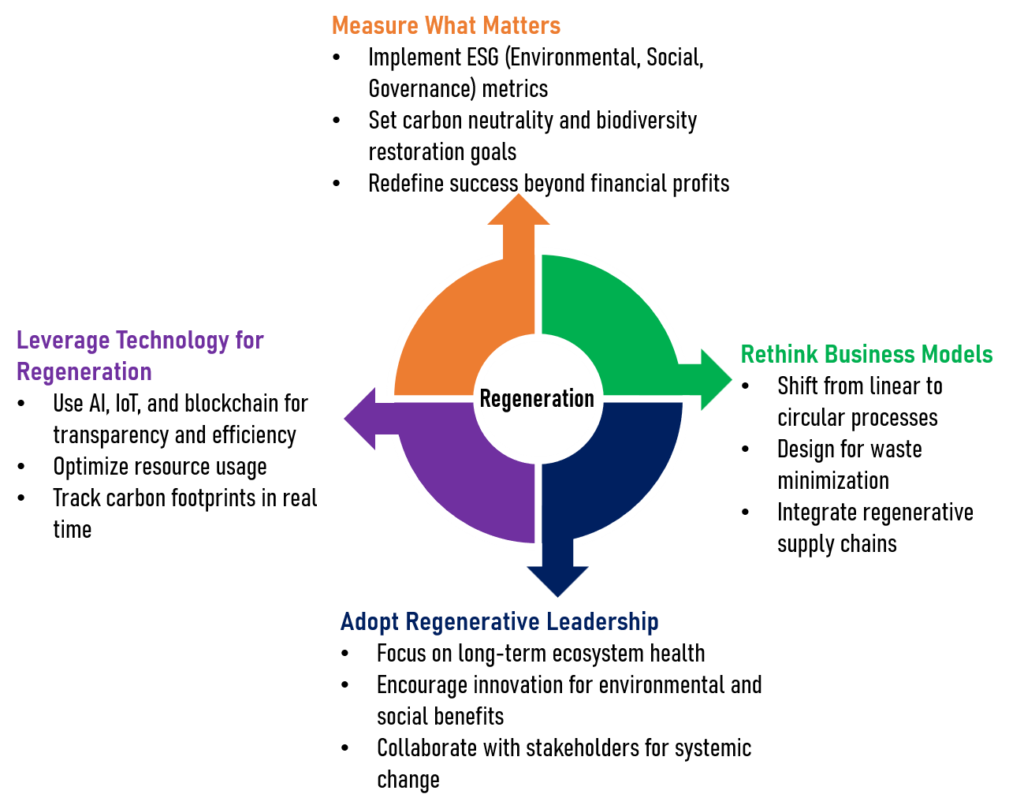Regenerative Organizations: Going Beyond Sustainability
The business landscape seems to shift and change, both with technology arrivals, shifts in socio-political scenarios and what not. That makes the concept of sustainability necessary, but no longer sufficient. Forward-thinking organizations are now embracing regenerative practices, to not just sustain but to restore and enhance the systems they operate within. This article explores the essence of regenerative organizations, their significance, with a detailed case study (right at the end) with quantifiable outcomes, and actionable strategies for businesses aspiring to transition toward a regenerative model.
Beyond Sustainability to Regeneration
The traditional sustainability paradigm focuses on minimizing harm and maintaining the status quo, and perhaps maintain the growth pace. In contrast, regenerative organizations strive to create systems that are dynamic, resilient, and beneficial to all stakeholders. This shift from a “do no harm” approach to a “do good” philosophy signifies a profound transformation (bordering on the philosophical) in how businesses perceive their role in society and the environment.
What are Regenerative Organizations
Regenerative organizations are entities that actively restore and rejuvenate ecological, social, and economic systems. Some call these organizations as “Connected”1. They operate on principles that prioritize the health of the whole eco-system and the society (at large), ensuring that their activities contribute positively rather than deplete resources. Key characteristics include:
- Holistic Systems Thinking: Recognizing the interconnectedness of all systems and making decisions that consider the broader impact on the environment, society, and economy.
- Circular Economy Integration: Designing processes where waste is minimized, and materials are continually repurposed, emulating natural cycles.
- Stakeholder Inclusivity: Engaging all stakeholders—employees, communities, suppliers, and customers—in value creation, ensuring equitable and inclusive growth.
The Imperative for Regenerative Organizations
The transition to regenerative practices is driven by pressing global challenges:
- Environmental degradation: Resource depletion, climate change, and biodiversity loss require solutions beyond sustainability. According to the United Nations, global carbon emissions must be reduced by 45%2 by 2030 to prevent catastrophic climate change. Regenerative organizations actively work to sequester carbon and restore natural ecosystems.
- Social instability: Economic social inequality demand systemic transformation. The World Economic Forum reports that the wealth gap between the richest and poorest 10% has been widening in most countries, leading, often, to social unrest and economic instability. Regenerative organizations ensure fair wages, equitable access to resources, and inclusive decision-making structures.
- Business resilience: Companies that regenerate rather than extract are more adaptive to economic shifts and disruptions. A piece of research by the Harvard Business Review suggests that businesses integrating regenerative practices experience 26% higher long-term financial performance than those focused solely on sustainability.
- Consumer Expectations: Modern consumers demand more than just sustainability claims. A Nielsen survey found that 73% of global consumers are willing to change their consumption habits to reduce environmental impact, increasing pressure on businesses to adopt regenerative models.
- Regulatory Pressure: Governments worldwide are implementing stricter regulations on sustainability and carbon footprints. The European Union’s Green Deal aims for carbon neutrality by 2050, requiring businesses to transform their operational strategies toward regeneration.
How Businesses Can Transition to a Regenerative Model
Organizations looking to move beyond sustainability and become regenerative will need to consider and the following strategies:
1. Rethink Business Models : Shifting from a linear to a circular economy approach involves redesigning product life cycles, minimizing waste, and incorporating regenerative supply chains.
2. Adopt Regenerative Leadership: Leaders in regenerative organizations focus on long-term ecosystem health rather than short-term profits. This requires the organisations to:
- Emphasize on collaboration over competition.
- Encourage innovation that benefits both business and society.
- Embed sustainability into core decision-making.

3. Leverage Technology for Regeneration: AI, IoT, and blockchain can enable regenerative systems by improving supply chain transparency, optimizing resource efficiency, and tracking carbon footprints.
4. Measure What Matters: Traditional financial metrics are insufficient to gauge regenerative impact. Companies need to incorporate appropriate ESG (Environmental, Social, Governance) indicators, carbon neutrality goals, and stakeholder well-being metrics into their reporting.
The Future of Regenerative Organizations
As businesses worldwide recognize the limitations of sustainability, the transition to regeneration will shape the next era of corporate strategy. Those that embrace regenerative principles will not only future-proof their organizations but also contribute to a thriving, resilient world.
Conclusion
Regenerative organizations represent the future of responsible business, proving that companies can be a force for renewal rather than depletion. By integrating systems thinking, circular economy practices, and stakeholder-driven value creation, organizations can move beyond sustainability and become catalysts for positive transformation.
Are you ready to take the leap toward a regenerative future?
Case Study: Patagonia: Pioneering Regenerative Agriculture
Founded in 1973, Patagonia is renowned for its commitment to environmental stewardship. Recognizing the detrimental effects of conventional agriculture—which accounts for approximately 30% of global CO₂ emissions and 60% of biodiversity loss—Patagonia has championed regenerative organic agriculture as a solution.
Initiatives and Impact:
- Regenerative Organic Certification (ROC): In collaboration with the Rodale Institute, Patagonia co-founded the Regenerative Organic Alliance in 2018. This coalition established the ROC, a rigorous standard emphasizing soil health, animal welfare, and social fairness. hardloop.co.uk
- Pilot Programs: Patagonia has initiated pilot projects across nine countries, encompassing over 550 farms. These programs focus on implementing regenerative practices such as no-till farming, cover cropping, and crop rotation. hardloop.co.uk
- Environmental Benefits: Studies indicate that regenerative agriculture can sequester significant amounts of CO₂. For instance, each hectare of restored agricultural land can reduce atmospheric CO₂ by up to 3 tons annually. hardloop.co.uk
- Economic Viability: Research has shown that regenerative plots can be up to 78% more profitable than conventional ones, offering a compelling case for widespread adoption. edie.net
The case study has been sourced from hardloop.co.uk and edie.net and compiled by an AI